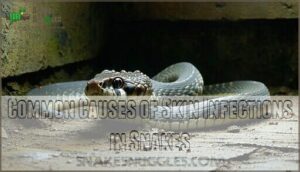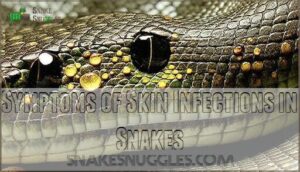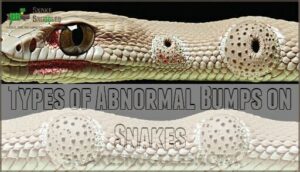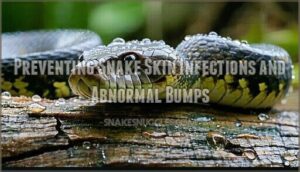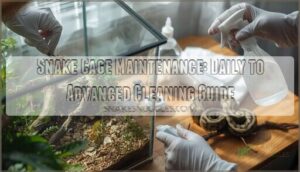This site is supported by our readers. We may earn a commission, at no cost to you, if you purchase through links.

You’ll spot flaky scales, redness, swelling, or mysterious lumps that weren’t there before.
These issues stem from poor humidity, dirty environments, parasites, or fungal invaders like Snake Fungal Disease.
Bacterial infections create angry red patches, while cysts and abscesses form hard bumps under the skin.
Think of your snake’s skin as a warning system – those bumps and patches are its way of saying "help me".
Quick action prevents minor issues from becoming major headaches.
The key lies in understanding what each symptom means and how environmental tweaks can work wonders.
Table Of Contents
- Key Takeaways
- Identifying Snake Skin Infections
- Understanding Abnormal Bumps on Snakes
- Snake Fungal Disease (SFD) and Skin Infections
- Creeping Eruption in Snakes
- Treatment Options for Snake Skin Infections
- Preventing Snake Skin Infections and Abnormal Bumps
- Managing and Caring for Snakes With Skin Infections
- Frequently Asked Questions (FAQs)
- What does a skin infection look like on a snake?
- What does snake fungal disease look like?
- What is bacterial dermatitis snake blister disease?
- How do parasites lead to skin abnormalities in snakes?
- Are abnormal skin bumps in snakes hereditary?
- Can stress contribute to snake skin health issues?
- How do nutritional deficiencies affect snake skin?
- Can snake skin infections spread to other pets?
- How long do skin infections take to heal?
- Are certain snake species more infection-prone than others?
- Conclusion
Key Takeaways
- You’ll recognize skin infections by watching for scale discoloration, redness, swelling, and unusual bumps that weren’t there before – these serve as your snake’s warning system.
- Poor humidity levels, dirty enclosures, and nutritional deficiencies create perfect conditions for bacterial, fungal, and parasitic infections to take hold.
- Treatment requires combining medical intervention (antibiotics or antifungals) with environmental improvements like proper humidity control and thorough enclosure cleaning.
- Prevention beats cure – maintain 50-60% humidity, clean substrates weekly, and schedule regular vet checkups to catch problems before they become serious issues.
Identifying Snake Skin Infections
When you spot unusual changes in your snake’s skin, you’re likely dealing with a potential infection that needs immediate attention.
Recognizing the early warning signs can mean the difference between a quick fix and a serious health crisis that threatens your pet’s life, which is why it’s crucial to address these issues promptly to prevent a serious health crisis.
Common Causes of Skin Infections in Snakes
Why do snakes develop skin infections? Poor hygiene creates bacterial breeding grounds while improper humidity fosters fungal growth.
Overcrowding increases stress and germ spread, weakening immune responses. Physical injuries open pathways for infection, and nutritional deficiencies leave snakes vulnerable.
Common culprits include:
- Poor Hygiene – Dirty substrates harbor harmful bacteria
- Enclosure Conditions – Wrong temperature and excessive moisture
- Nutritional Deficiencies – Lack of vitamin D3 weakens immunity
- Physical Injuries – Wounds invite bacterial and fungal invasion
- Mite Contact – Parasites spread disease through infested substrates
Symptoms of Skin Infections in Snakes
Identifying snake skin infection requires keen observation.
Watch for redness, swelling, and blister formation on scales.
Scale discoloration often appears yellow, green, or black.
Appetite changes signal illness, while abnormal skin bumps indicate infection.
Check for skin lesions and scale changes regularly.
| Symptom | Visual Indicator |
|---|---|
| Lesion Appearance | Open wounds, ulcers |
| Blister Formation | Fluid-filled pustules |
| Scale Discoloration | Yellow, green, black patches |
| Swelling Severity | Raised, inflamed areas |
Types of Skin Infections in Snakes
When dealing with snake health issues, you’ll encounter three main infection categories that can wreak havoc on your scaly friend’s wellbeing:
- Bacterial infections cause red, inflamed skin and blister disease from dirty habitats
- Fungal infections create crusty scales and abscesses, often requiring antifungal treatment
- Parasitic infections from mites cause skin lesions and irritation
Each type demands different treatment approaches for effective recovery.
One example of a fungal issue is snake fungal disease, which can cause severe skin problems.
How to Recognize Skin Infections in Snakes
Something’s wrong when you spot early signs of snake skin infection on your pet. Scale discoloration appears as yellow, green, or black patches. Watch for blister identification markers like fluid-filled bumps and lesion appearance showing crusty sores. Behavioral changes include lethargy and appetite loss.
| Symptom | What to Look For |
|---|---|
| Scale Discoloration | Yellow, green, or black patches |
| Blisters | Fluid-filled bumps on scales |
| Lesions | Crusty, oozing sores |
| Swelling | Raised, inflamed areas |
| Shedding Issues | Retained or patchy skin |
Early detection prevents skin lesions from worsening into serious complications, which is why it’s crucial to identify symptoms like scale discoloration and blisters to ensure proper care for your pet.
Understanding Abnormal Bumps on Snakes
When you spot unusual bumps on your snake’s skin, you’re looking at potential signs of infection, parasites, or other health issues that need quick attention.
These abnormal growths can range from harmless cysts to serious bacterial infections, so knowing what to watch for helps you act fast and keep your scaly friend healthy.
Types of Abnormal Bumps on Snakes
Different bump types on your snake’s skin tell unique stories about their health.
- Abscesses appear as firm lumps with solid pus requiring surgical removal
- Cysts feel soft and fluid-filled, sometimes needing periodic drainage
- Tumors manifest as progressive masses affecting skin, muscle, or bone
- Parasitic bumps from mites and ticks create visible irritation near eyes and lips
These abnormal bumps range from minor scale deformities to serious tumor manifestations requiring immediate attention.
Most snake lumps are actually abscesses.
Causes of Abnormal Bumps on Snakes
Various factors contribute to abnormal bumps on your snake’s skin.
Environmental stress, poor hygiene, and inadequate nutrition create perfect conditions for these unwelcome visitors to appear.
- Parasitic Infestations: Mites and ticks burrow under scales, creating raised bumps and irritation
- Cyst Development: Blocked pores or injury sites form fluid-filled lumps beneath the skin
- Tumor Growth: Both benign and malignant growths appear as firm, irregular masses
- Abscess Formation: Bacterial infections create pus-filled pockets that feel warm and swollen
- Scale Damage: Trauma from rough surfaces causes scar tissue and permanent skin lesions
Symptoms Associated With Abnormal Bumps on Snakes
When you spot an abnormal bump on your snake, watch for telltale symptoms that’ll help you piece together what’s happening.
These bump characteristics and associated symptoms act like breadcrumbs leading to the root cause.
| Symptom Category | What to Watch For |
|---|---|
| Physical Changes | Redness, swelling, discharge, color shifts |
| Behavioral Signs | Lethargy, appetite loss, excessive rubbing |
| Location significance | Ventral scales, head/neck, injury sites |
| Severity indicators | Size increase, multiple bumps, open wounds |
Snake skin lesions often come with friends – you might notice your pet acting sluggish or refusing meals alongside visible skin lesions.
How to Identify Abnormal Bumps on Snakes
Identifying abnormal bumps on your snake requires careful visual inspection and gentle palpation techniques.
Check for changes in scale abnormalities, noting bump location and size variations. Watch for behavioral changes like excessive rubbing or lethargy.
Here’s your identification checklist:
- Feel the difference – Soft bumps suggest abscesses, while hard ones indicate tumors or cysts
- Map the mystery – Document where snake skin lesions appear on your snake’s body
- Size matters – Large, discolored bumps often signal serious snake skin infection requiring immediate attention
Snake Fungal Disease (SFD) and Skin Infections
Snake Fungal Disease (SFD) isn’t just another skin problem—it’s a serious threat that’s been quietly spreading through North American snake populations since 2006.
You’ll want to catch this fungal infection early because it can literally eat away at your snake’s skin and potentially kill them within months if left untreated.
What is Snake Fungal Disease (SFD)?
Snake Fungal Disease (SFD) comes from the fungus Ophidiomyces ophiodiicola, a sneaky environmental organism lurking in soil.
This fungal infection spreads through contaminated habitats, affecting multiple snake species across North America.
SFD identification reveals it’s becoming a serious threat to snake populations, causing significant mortality rates and ecosystem disruption.
The disease spread continues expanding geographically.
Symptoms of SFD in Snakes
SFD symptoms hit snakes hard with facial swelling and nodular lumps appearing first.
Crusty lesions develop into ulcerated skin, creating abnormal bumps across their body.
Watch for systemic spread – this snake fungal disease can cause organ involvement, making infected snakes lethargic and weak.
Early detection saves lives.
How SFD Affects Snake Skin
When SFD strikes, your snake’s skin becomes a battlefield.
Ophidiomyces ophiodiicola creates crusty lesions and scale disfigurement that compromise your pet’s quality of life.
This fungal invader doesn’t just affect appearance—it impacts survival.
SFD symptoms transform healthy snake skin through:
- Facial swelling and nodular lumps that restrict movement
- Hunting impairment from physical disfigurement and reduced agility
- Population impact with 40% mortality rates in affected snakes
- Ulcerations that progress from small lesions to serious wounds
Treatment Options for SFD in Snakes
Fighting fungal foes requires antifungal medications like terbinafine and itraconazole.
You’ll need supportive care with proper hydration and nutrition.
Environmental remediation means deep cleaning your snake’s habitat.
Severe cases may require surgical intervention to remove infected tissue.
Always seek vet consultation for proper antifungal therapy – your snake’s recovery depends on swift action.
Creeping Eruption in Snakes
Creeping eruption in snakes is a skin condition that causes raised, winding tracks or bumps beneath the skin’s surface as parasites migrate through tissue.
You’ll typically notice this condition when your snake has been exposed to contaminated substrates or has nutritional deficiencies that weaken its immune system.
What is Creeping Eruption in Snakes?
Nutritional neglect can trigger creeping eruption in your snake’s delicate skin system. This condition involves cutaneous larva migrans where hookworm larvae create distinctive itchy trails beneath the surface.
Diet deficiency weakens your pet’s immune defenses against larval parasites. One potential cause is nutritional deficiencies, which can lead to abnormal molting.
- Larval migrans causes visible creeping symptoms across affected areas
- Zoonotic risk exists if you handle infected snakes without gloves
- Hookworm larvae burrow through skin creating characteristic tunnel patterns
- Preventative measures include proper nutrition and regular health monitoring
Causes of Creeping Eruption in Snakes
Understanding what triggers creeping eruption helps you protect your snake from this uncomfortable condition.
Hookworm larvae cause this skin problem when they burrow under your pet’s scales, creating those characteristic itchy trails.
Dietary deficiencies weaken your snake’s immune system, making parasitic exposure more likely to result in cutaneous larva migrans.
Poor enclosure hygiene creates perfect conditions for larval parasites to thrive, while wound contamination provides easy entry points for these unwanted invaders.
Symptoms of Creeping Eruption in Snakes
Once you know what causes creeping eruption, you’ll want to spot the telltale signs on your snake’s skin.
This snake skin infection creates distinctive patterns that help you identify larval migrans before it worsens.
Watch for these key symptoms of creeping eruption:
- Red trails that zigzag across your snake’s skin like tiny roadmaps
- Skin lesions that appear raised and inflamed along the migration paths
- Itch intensity causing excessive rubbing against enclosure surfaces
- Affected areas showing discoloration or scaling abnormalities
- Secondary infections developing where scratching has damaged the skin
These symptoms distinguish creeping eruption from other snake skin infection types through their characteristic wandering pattern.
Treatment Options for Creeping Eruption in Snakes
Once you’ve spotted those telltale symptoms, effective treatment becomes your next priority.
Oral albendazole (400mg daily for 3-5 days) and ivermectin (200μg/kg) offer the highest success rates against creeping eruption.
These anthelmintic medications target the parasitic larvae directly.
For localized lesions, apply topical thiabendazole cream twice daily.
Implement strict quarantine protocols and focus on lesion care to prevent secondary infections.
Proper antibiotic treatments help if bacterial complications develop through scratching.
Treatment Options for Snake Skin Infections
When your snake develops skin infections, you’ll need a targeted treatment plan that combines medical intervention with habitat improvements.
The right approach depends on whether you’re dealing with bacterial, fungal, or parasitic infections, but most cases respond well to prompt veterinary care and environmental adjustments.
Antibiotic Treatments for Skin Infections in Snakes
When bacterial culprits like Pseudomonas and Aeromonas invade your snake’s skin, antibiotic treatments become essential warriors in the fight.
Antibiotic Types range from injectable to oral forms, each with specific Administration Methods and Dosage Calculation requirements.
Treatment Duration typically spans 7-14 days, though Resistance Concerns make veterinary guidance vital.
Your reptilian buddy’s recovery depends on proper medication timing and consistent care throughout the healing process.
Topical Treatments for Skin Infections in Snakes
When battling snake skin infection, topical treatments pack a punch. Antiseptic solutions and antibiotic ointments tackle bacterial invaders head-on. Tea tree oil works wonders but requires careful dilution.
Apply treatments twice daily using gentle dabbing motions. Treatment duration typically spans 7-14 days.
Rotate antifungal options to prevent resistance. You can find a variety of suitable antiseptic products online.
Always consult your vet before starting any regimen—your snake’s health deserves professional guidance.
Environmental Changes for Skin Infections in Snakes
While topical treatments address the surface, your snake’s environment plays an equally important role in recovery. Smart environmental changes can transform your pet’s healing process and prevent future infections.
Creating the right habitat involves multiple factors working together. Humidity Control prevents fungal growth while Substrate Selection eliminates bacterial breeding grounds. Enclosure Cleaning removes contamination sources, and proper Temperature Gradients boost your snake’s immune system. Quarantine Protocols protect other pets during treatment.
To confirm complete recovery, consider antibiotic therapy options.
- Maintain humidity levels between 50-60% using a reliable hygrometer
- Improve ventilation with adequate air circulation systems
- Replace clean substrate weekly during infection treatment
- Keep consistent temperature range within your species’ requirements
Surgical Options for Skin Infections in Snakes
When environmental modifications don’t resolve your snake’s skin infection, surgical intervention becomes necessary.
Abscess drainage and diseased tissue removal target infected areas that antibiotics can’t reach effectively.
| Surgical Procedure | Purpose | Recovery Time |
|---|---|---|
| Abscess Drainage | Remove pus buildup | 2-4 weeks |
| Scale Reconstruction | Repair damaged scales | 6-8 weeks |
| Wound Closure | Seal surgical sites | 4-6 weeks |
Post-surgical care requires strict hygiene protocols and monitoring for complications like infection recurrence.
Preventing Snake Skin Infections and Abnormal Bumps
You’ll prevent most snake skin infections by maintaining proper humidity levels and keeping your pet’s enclosure spotlessly clean.
Regular health checks and quality nutrition work like insurance policies—they catch problems early and keep your snake’s immune system strong enough to fight off infections before they start, which is crucial for preventing infections and maintaining your snake’s overall health, making proper humidity a key factor.
How to Prevent Skin Infections in Snakes
Keeping your snake healthy starts with habitat hygiene and regular cleaning of their enclosure.
Proper diet and nutrition strengthen their immune system against snake skin infection.
Maintain ideal temperature and humidity levels while implementing quarantine protocols for new animals.
Stress reduction through consistent reptile skin care and regular checkups creates effective preventative measures against infections.
Tips for Maintaining a Healthy Snake Environment
Creating the right environment for your snake is like building a fortress against snake skin infection. Habitat Maintenance starts with Temperature Control using proper heating gradients and Humidity Levels between 50-60% for most species. Your Substrate Choice matters—avoid cedar shavings that irritate skin. Regular Cleaning with reptile-safe disinfectants prevents bacterial buildup.
To guarantee a safe habitat, consider using reptile safe cleaners during routine maintenance. Think of it as your snake’s personal spa day!
- Temperature: Provide a proper temperature gradient
- Humidity: Maintain good humidity levels
- Enclosure: Make sure it’s the right size and has good ventilation
Here’s what’ll keep your slithery friend thriving:
- Clean water bowls weekly to prevent bacterial growth that causes skin problems
- Replace substrate monthly to eliminate hidden pathogens lurking in old bedding
- Monitor temperatures daily because stressed snakes from wrong temps get sick faster
Importance of Regular Veterinary Check-Ups
Beyond maintaining ideal housing conditions, regular vet checkups serve as your snake’s health insurance policy.
These wellness exams enable early detection of skin problems before they escalate into serious infections.
Your snake vet provides expert advice on preventative care and creates effective treatment planning strategies.
Smart health monitoring through routine visits prevents minor issues from becoming major headaches.
Managing and Caring for Snakes With Skin Infections
When your snake develops a skin infection, quick action and proper care can make the difference between a full recovery and serious complications.
You’ll need to balance medical treatment with supportive care while keeping your scaly patient as comfortable as possible during the healing process.
Managing Pain and Discomfort in Snakes With Skin Infections
When prevention fails, managing your snake’s discomfort becomes your priority.
Pain assessment involves observing behavioral changes like reduced movement or appetite loss.
Comfort measures focus on creating stress-free environments while medication options remain limited for reptiles.
Proper handling techniques minimize additional trauma during wound care procedures.
- Hydration stations: Fresh water bowls help maintain skin moisture and support healing
- Gentle baths: Lukewarm soaks soften infected areas and provide pain relief
- Minimal handling: Reduce stress by limiting unnecessary contact during treatment
- Temperature control: Maintain ideal basking spots for immune system support
Snakes require a suitable water bowl for hydration.
Nutritional Support for Snakes With Skin Infections
When dealing with skin infections, your snake’s body needs extra fuel to fight back and heal damaged tissue.
Proper nutrition becomes your secret weapon against nutritional deficiencies that weaken recovery.
| Nutrient | Benefit | Source | Dosage |
|---|---|---|---|
| Vitamin D3 | Boosts immunity, calcium absorption | Supplementation | As directed by vet |
| Calcium | Strengthens immune system | Dusted prey | 10-20mg/kg |
| Vitamin C | Supports collagen synthesis | Supplements | 10-20mg/kg |
| B Vitamins | Enhances metabolism, shedding | Multivitamin injections | Weekly doses |
Focus on calcium intake and vitamin D3 supplementation while ensuring proper hydration importance through clean water access.
These feeding strategies help correct mineral deficiencies that slow healing.
Monitoring Progress and Adjusting Treatment Plans
When tracking snake skin infections, don’t just wing it—watch for changes daily.
Adjust treatment for best results: tweak Dosage Adjustments, monitor for Symptom Relapse, and stay alert for Secondary Infections.
Schedule regular veterinary care for Long-Term Care. A key aspect involves maintaining proper humidity to prevent further complications.
- Check healing progress after each dose
- Watch for signs of relapse or new bumps
- Update treatment for improved Treatment Efficacy
Frequently Asked Questions (FAQs)
What does a skin infection look like on a snake?
You’ll spot snake skin infections through discolored patches that look yellow, green, or black on their scales. Red, swollen areas with blisters or crusty lesions signal trouble brewing underneath.
What does snake fungal disease look like?
A timber rattlesnake in New Hampshire showed telltale signs in 2006 – the first confirmed case.
You’ll notice facial swelling, crusty nodular lumps, and deep ulcerative lesions that create a pitted, scarred appearance.
The fungus literally eats away at scales.
What is bacterial dermatitis snake blister disease?
Bacterial dermatitis, commonly called blister disease, develops when bacteria infect your snake’s skin in dirty, overly moist environments.
You’ll notice fluid-filled blisters and red, inflamed patches that can become life-threatening without treatment.
How do parasites lead to skin abnormalities in snakes?
Parasites like mites and ticks create abnormal bumps by irritating your snake’s skin directly.
They bite and feed, causing raised bumps, scale lifting, and excessive rubbing that leads to wounds and secondary infections.
Are abnormal skin bumps in snakes hereditary?
Most abnormal skin bumps in snakes aren’t hereditary.
You’ll typically see them from infections, parasites, injuries, or poor habitat conditions.
Genetics rarely cause these bumps directly, though some snakes inherit weaker immune systems that make infections more likely, which can be considered an indirect cause of abnormal skin bumps.
Can stress contribute to snake skin health issues?
Yes, stress substantially weakens your snake’s immune system, making it vulnerable to bacterial, fungal, and parasitic skin infections.
Overcrowded enclosures and poor environmental conditions create the perfect storm for health problems.
How do nutritional deficiencies affect snake skin?
Like a car running on empty fuel, your snake’s body struggles without proper nutrition.
Nutritional deficiencies, especially vitamin D3 and calcium shortages, weaken your snake’s immune system.
Making it vulnerable to skin infections and slower healing, due to nutritional deficiencies.
Can snake skin infections spread to other pets?
Most snake skin infections won’t spread to other pets, but some parasites like mites can jump between animals.
You’ll want to quarantine infected snakes and clean thoroughly to prevent cross-contamination between reptiles, which helps prevent the spread of parasites.
How long do skin infections take to heal?
Imagine this: healing skin is like watching grass grow after winter damage – you’ll see progress, but patience is your best friend.
Your snake’s skin infection typically takes 2-4 weeks to heal with proper treatment, though severe cases might need 6-8 weeks.
Are certain snake species more infection-prone than others?
Some snake species face higher infection risks due to genetics and behavior.
Timber rattlesnakes, eastern massasaugas, and milk snakes show particular vulnerability to fungal diseases like SFD.
While proper husbandry helps protect all species.
Conclusion
Take Sarah’s ball python, Max, who developed mysterious bumps after she moved his terrarium near a drafty window.
What seemed like harmless lumps turned into a serious bacterial infection within days.
Your snake’s skin tells a story – those unusual patches and bumps aren’t just cosmetic issues.
Snake skin infection and abnormal bumps require immediate attention and proper environmental management.
You’ve got the tools to spot problems early and create the perfect healing environment.
Remember, consistent humidity levels and clean substrates prevent most issues before they start.
- https://www.merckvetmanual.com/exotic-and-laboratory-animals/reptiles/bacterial-diseases-of-reptiles
- https://www.wildlifedemonstrations.com/post/scale-rot-how-to-identify-and-treat
- https://www.petplace.com/article/reptiles/general/lumps-and-bumps-in-snakes
- https://dnr.wisconsin.gov/topic/endangeredresources/snakefungal
- https://www.ingleside.com/services/other-pets/blog/skin-and-shell-infections-reptiles-causes-symptoms-and-treatment

